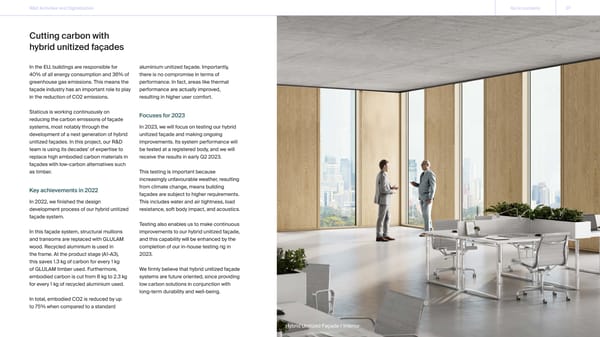R&D Activities and Digitalization Go to contents 27 Cutting carbon with hybrid unitized façades In the EU, buildings are responsible for aluminium unitized façade. Importantly, 40% of all energy consumption and 36% of there is no compromise in terms of greenhouse gas emissions. This means the performance. In fact, areas like thermal façade industry has an important role to play performance are actually improved, in the reduction of CO2 emissions. resulting in higher user comfort. Staticus is working continuously on Focuses for 2023 reducing the carbon emissions of façade systems, most notably through the In 2023, we will focus on testing our hybrid development of a next generation of hybrid unitized façade and making ongoing unitized façades. In this project, our R&D improvements. Its system performance will team is using its decades’ of expertise to be tested at a registered body, and we will replace high embodied carbon materials in receive the results in early Q2 2023. façades with low-carbon alternatives such as timber. This testing is important because increasingly unfavourable weather, resulting Key achievements in 2022 from climate change, means building façades are subject to higher requirements. In 2022, we finished the design This includes water and air tightness, load development process of our hybrid unitized resistance, soft body impact, and acoustics. façade system. Testing also enables us to make continuous In this façade system, structural mullions improvements to our hybrid unitized façade, and transoms are replaced with GLULAM and this capability will be enhanced by the wood. Recycled aluminium is used in completion of our in-house testing rig in the frame. At the product stage (A1-A3), 2023. this saves 1.3 kg of carbon for every 1 kg of GLULAM timber used. Furthermore, We firmly believe that hybrid unitized façade embodied carbon is cut from 8 kg to 2.3 kg systems are future oriented, since providing for every 1 kg of recycled aluminium used. low carbon solutions in conjunction with long-term durability and well-being. In total, embodied CO2 is reduced by up to 75% when compared to a standard Hybrid Unitized Façade / Interior
 Capability Statement Page 26 Page 28
Capability Statement Page 26 Page 28